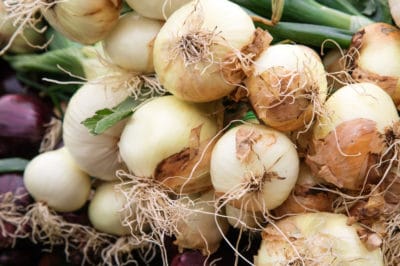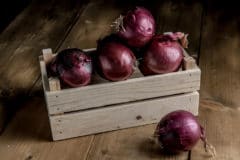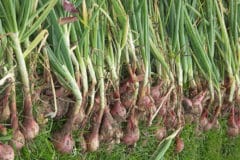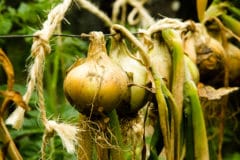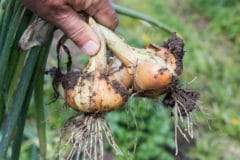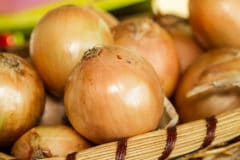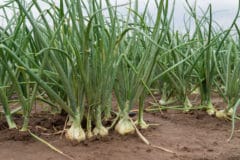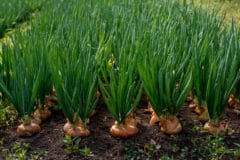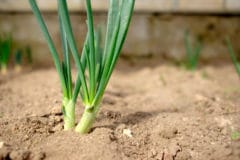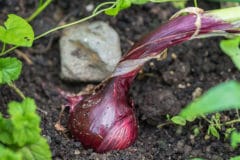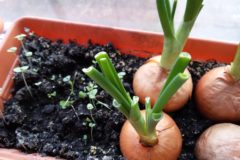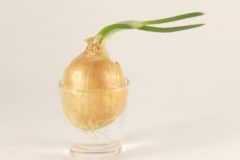Onion Varieties That Keep Well
Some onion varieties keep better than others do, so if you planted the following varieties, you’re in luck. Other types of onions are also good for storing, but the following are known as good keepers:
- Copra
- Burpee Yellow Gold Hybrid
- Ebenezer
- Marathon Hybrid
- Golden Cascade
- Rip Van Winkle
- Southport Red Globe
- Yellow Globe Danvers
- Norstar
- Sweet Sandwich
Best Way to Harvest Onions
Before thinking about storage for your onions, it’s necessary to follow a few steps for harvesting and curing. Begin pulling your onion bulbs as soon as they’re mature. You can tell when your onions are mature when the onion tops fall over, start to dry out and waste away. When most of your onions have fallen tops, begin harvesting them. Follow these steps for the best way to harvest your onions:
- Gently pull your onions from the soil or use a garden fork to loosen them, being careful not to pierce the bulb.
- Allow the bulbs to rest on top of the soil.
- Leave the onions in the garden to cure for one to two weeks.
- If you expect rain during any of the drying time, move your onions to a protected, dry area to finish curing.
The onion tops are almost completely dry for perfectly cured onions.
Get Your Onions Ready for Storage
After you’ve cured your onions, trim the tops off the bulb. Some of your onions won’t have any stems left because they might fall off after drying completely. If you prefer to leave the dried stems on your onions, you can use them to braid the onions for storage.
Examine all your onion bulbs before storing. Make sure none of the onions has cuts or bruises. Also, check for soft spots and rot. You don’t want to store these with healthy onions because the moisture caused by the injured onions can spread to the good ones.
After discarding the injured onions, remove the roots, making sure they’re clean and dry.
As they grow in your garden, some onions develop thick necks. These don’t keep very well, so it’s a good idea to use them right away.
How to Store Onions
No matter which onion variety you pulled from your garden, storing your onions under the right conditions will keep your harvest fresh from fall through the winter. You can use the following storage containers that provide plenty of air circulation for your onion bulbs:
- Mesh bag
- Wire basket with mesh covering
- Wooden crate covered with burlap
- Nylon stockings
- Ventilated barrel
- Slatted Crate
These containers prevent the onions from sweating and gathering moisture, which can make them start growing again. Even a small amount of moisture can cause your onions to rot.
Simple Storage Areas for Onions
The first thing to consider when storing your onions is the temperature. The best temperature for storage ranges from 32ºF (0ºC) to 40ºF (4.4ºC) with 70 percent humidity. Natural cold storage has ideal conditions for keeping onions. These areas include an enclosed porch, a garage, the basement or a root cellar.
If you decided to tie or braid your onions together, you can hang them in your basement, garage or root cellar. If you put any onions in an outdoor shed, keep track of the temperature and move them to a warmer storage area if the temperature drops below freezing.
Consider a Root Cellar
Not many people today consider a root cellar but it’s easy to build your own for storing all kinds of vegetables during the winter. A root cellar or cold cellar provides a reliable, eco-friendly way to store your onions and other vegetables. It’s built underground or partially underground, or can be part of your home.
It provides good air circulation, above-freezing temperatures and moderate humidity. No matter what size your home or yard, you have space for a root cellar. Here are several types of root cellars that you can incorporate into your home:
Basement Root Cellar
You can modify an area of your basement for a storage root cellar. Whether it’s just a small corner or small room, it will work for storing onions. All you have to do is wall off the area, so it stays at a consistently cool temperature, especially if your basement has heat.
Underground Root Cellar
If you have any hills in your yard, you can dig a root cellar right into the hill. The soil keeps the temperature naturally cool. You can attach a door to the dugout area for easy access. Your root cellar can be as simple as burying a large bucket or trash barrel in the ground with a secure cover. This is convenient if you only want to store a small amount of onions.
An Existing Area of the House
You can use several areas of your home as root cellars to preserve onions and other vegetables. The spot can be anywhere in your house that stays cool, such as an enclosed closet, alcove, enclosed space under a deck or porch, or a cubbyhole under the basement stairs.
How Long Will Onions Stay Fresh in Storage?
The amount of time your onions will keep in storage depends on the variety you planted and the climate conditions provided. If you control the temperature and humidity, your onions should stay fresh for several months.
For short-term storage, you can put your onions in the fridge. Only do this if you’re planning to use your onions within a week or two. When storing them in the refrigerator, the National Onion Association suggests wrapping the dried onion in a paper towel or newspaper and put it in a spot where it will stay dry.
